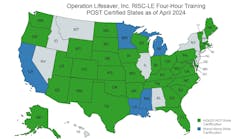City administrators, technology vendors, transit security professionals and law enforcement officials from across the nation gathered last week at the Secured Cities conference in Chicago, Ill., to network with peers and learn about the latest trends impacting municipal surveillance projects.
Cities need to have all key stakeholders (police, fire/EMS, city government, Homeland Security, transit, utilities) at the same table if they want to provide an effective security or safety response to any situation affecting their citizens. Increasingly, cities are inclined to make federated security technology, equipment and training investments, such that resources can be shared across agencies and departments.
Planning Partners
David Stolerow with HOH Systems Inc., the architect of record for Metra’s CCTV upgrade, presented on “Designing Video Surveillance for Mass Transit Security,” detailing some of the strategies on how they updated this system.
The project would include 1,358 cameras across seven locations, more than 350,000 feet of conduit, more than 145,000 feet of fiber cabling, nine consoles for viewing stations and it would all culminate in 99 drawings for this massive electrical project funded by a multiple-year grant through the Department of Homeland Security.
The first thing to be done was to assess where they were at and to know the objectives. The police wanted to have facial recognition and no delays. They created a wish list and talked about what could and could not be done and looked at what was existing and how the new system would connect.
You need to start with a basic design Stolerow said, so they conceptualized the design and looked at the network.
Next was teaching the customer. At the time they first looked at new cameras, about six years ago, they didn’t know if they wanted to go with analog or IP because at that time, IP still had a way to go.
Stolerow said they brought in major camera manufacturers and they each presented where IP cameras are at today. He said utilizing the vendors makes the vendors aware of the project and it helps the client understand the technology.
They brought in various video management systems, as well. The city has Genetec and DHS and the city require the cameras to feed into the city.
When the police played with the Genetec system, they could do everything without any training because it’s similar to how SNS worked. This would require minimal training time.
How to pick the camera? It’s a harsh environment with tunnels, harsh light and vandalism. Every camera on the platform was treated as an external camera, with heaters and blowers.
With the basic concept established, it was time to start design drawings. (This was about three months into the project.)
Cameras are 30 to 50 feet apart on platforms – both sides, both directions. They wanted the cameras to detect baggage set down, but in the transit environment, that would be triggered all the time. Instead, they went with every square inch of floor space covered so they could see everything.
Cameras chosen were 1080P and were placed at each entrance and exit so facial recognition could be utilized later; the system won’t be quickly antiquated.
Stolerow said that more than 100 Terabytes of storage is needed per day and Metra has a 30-day requirement. They are also considering a 90-day requirement. The system has redundancy built in everywhere, as that was important for Metra.
The analytics will actively monitor the public space and provide active alarms for anomalies. For example, the first time someone climbs a ladder changes a light bulb, Stolerow said, it will trigger an alarm. The user can say to ignore that. He said it takes six to nine months to train it with false alarms.
They put eight cameras as a test for nine months and two examples of anomalies it picked up were kids leaning over a ledge, over the tracks and a package someone left under a bench when they stepped more than 10 feet away to go purchase their ticket.
Initially there were 60 to 100 alarms per hour when they started and now it’s at 1.2 cameras per day, some getting an alarm every other day.
Emerging Technologies
Smiths Detection’s Anthony Pocari spoke on “Emerging Technologies for Mass Transit CBRNE Systems.” As he said, agencies know there is a low probability, but there are very high consequences if it does occur. And, terrorists know that chemical attacks work.
There are primarily two types of technology used for detection: “hand-helds” for individual threats, such as K-9 units or selective screening to swab bags; or to protect an entire area with chemical detectors.
While Pocari couldn’t share specifics, of course, about where detectors are located or what chemicals are detected, he provided information on what some of the latest technologies in use are doing to protect agencies.
At WMATA, the key is to get an early alert with the chemical detector so that a response can happen within a few minutes of when the chemical is released. Once released, the alert is cued at the command center and they are able to access CCTV verification.
Firefighters are able to connect with their laptops to see what’s going on inside so they know what they are walking in to.
Because of the integration between facility and responders, Pocari said it’s important to visit with all users and stakeholders to find out what each need.
Important to the agency was that the system be “stupid-proof,” so it’s intuitive. Almost to the extent that if they forgot everything, it would still work so that if anyone freezes at the time of an incident, it will still work.
When it comes to autonomous detectors for biohazards, Pocari said he doesn’t think we’ll see something for about five years yet. Particulate samplers in systems are taken twice daily, but you won’t know about an attack for 12 to 36 hours.
And, if you release Anthrax on a subway, the train just moves it: pushes it out and four hours later it’s gone to the outdoors, on the train car filters, in the track bed, etc. The transit system mitigates it, itself within about four hours, so currently the systems detect to treat, not to protect.
There is an exploratory study going on at the MBTA for a detect-to-protect system that would potentially provide confirmation in 30 to 60 minutes of exposure.
Pocari summarized a few future trends we can expect:
- Chem systems will expand to add radiation, nuclear, bio and explosive detection
- CBRNE systems will be integrated to the PSIM solution
- Advanced detection systems will be used to enhance CBRNE response
- Lifecycle costs are more important in design due to budget pressures.
The next Secured Cities conference will be October 10 - 11, 2012, in Philadelphia, Pa.



